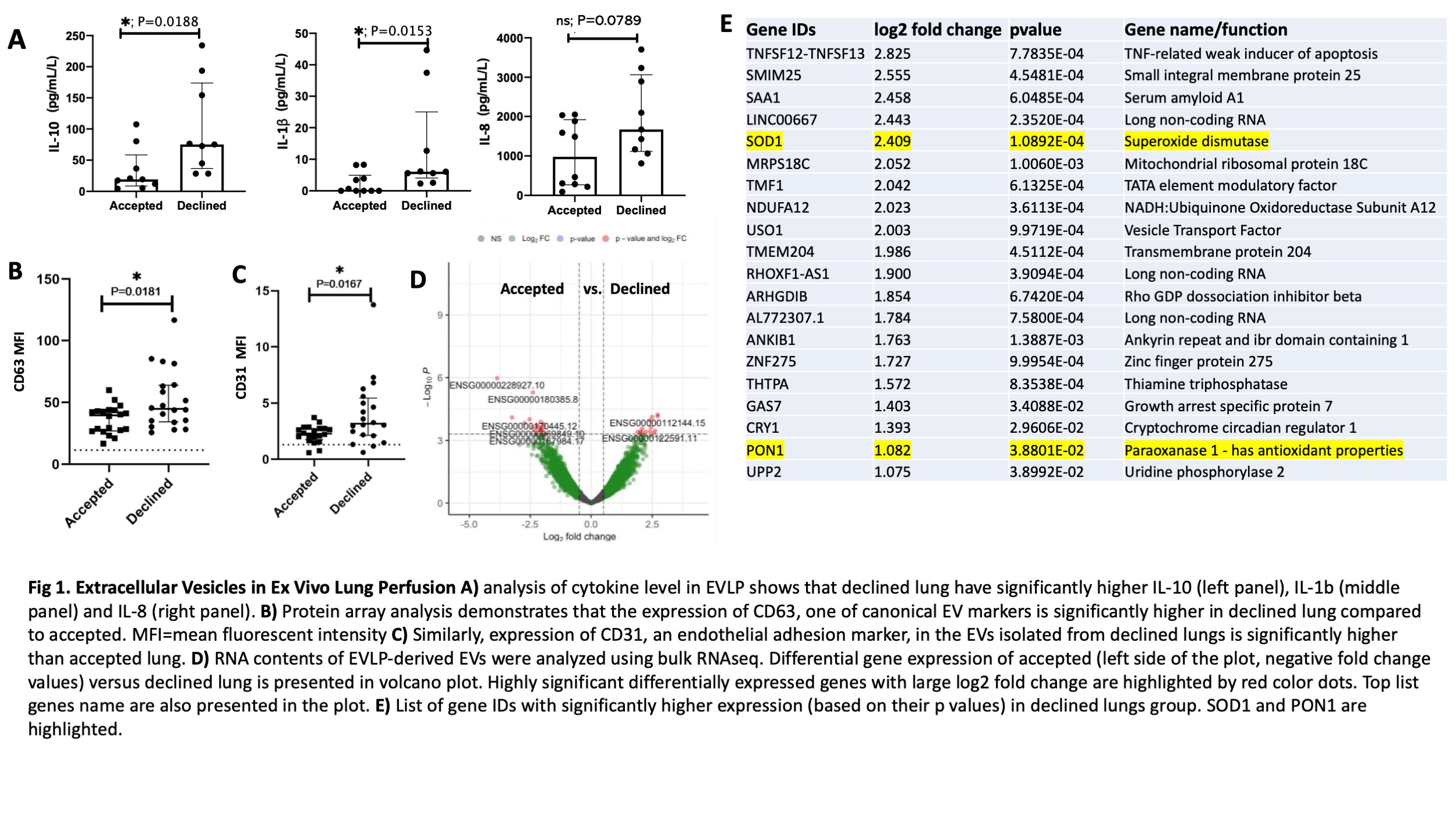CD31+ Extracellular Vesicles in Ex Vivo Lung Perfusion Are Associated with Unsuitability for Transplant
1Temerty Faculty of Medicine, University of Toronto, Toronto, ON, Canada, 2University Health Network, Toronto, ON, Canada, 3Multi-Organ Transplantation, University Health Network, Toronto, ON, Canada
Meeting: 2022 American Transplant Congress
Abstract number: 388
Keywords: Donors, marginal, Gene expression, Lung transplantation, Perfusion
Topic: Basic Science » Basic Science » 15 - Machine Perfusion and Organ Rehabililtation - Basic
Session Information
Session Time: 8:25am-9:30am
 Presentation Time: 8:45am-9:00am
Presentation Time: 8:45am-9:00am
Location: Hynes Veterans Auditorium
*Purpose: Primary graft dysfunction (PGD) is an important cause of morbidity and mortality following lung transplantation and results in part from injuries sustained in the donor. Extracellular vesicles (EVs) have been implicated in the anti-donor response to the lung allograft and may play a role in the pathogenesis of PGD. Perfusate from ex-vivo lung perfusion (EVLP) allows interrogation of donor EVs which may reflect lung injury sustained in the donor. In this study, we aimed to characterize the differential protein and RNA expression of EVs derived from perfusates of donor lungs accepted or declined for transplantation.
*Methods: 40 marginal lungs underwent EVLP to assess their suitability for transplant. 1-hr perfusate samples were collected and ultracentrifuged at 100,000xg for 90mins to isolate small EVs. EV protein arrays were used to investigate differences in protein content between lungs accepted for transplant (n=20), and injured lungs declined for transplant (n=20). Perfusate cytokines were also measured by ELISA. Then, total mRNA from a subset of the same samples (n=12 accepted, n= 12 declined) was isolated using the ThermoFisher miRVana miRNA isolation kit and sequenced via NovaSeq.
*Results: Compared to accepted lungs, declined lungs had higher perfusate IL-1b, IL-8 and IL-10 concentrations (Fig 1A). CD63, one of the canonical EV markers, and CD31, an endothelial adhesion marker, were found to be elevated in EVs from declined lungs (p=0.0183; p=0.0167) (Fig 1B-C). Whole transcriptome sequencing of donor EV RNAs revealed 36 differentially regulated genes, including several non-coding RNAs and enzymes involved in control of oxidative stress such as superoxide dismutase 1 and paraoxanase 1 (Fig 1D-E).
*Conclusions: EVLP-derived EVs protein and RNA profiling revealed a preponderance of endothelium-derived CD31+ EVs in declined lungs. Declined lung EVs contained a greater abundance of transcripts encoding non-coding RNAs and antioxidant enzymes. An analysis of microRNAs contained in donor EVs is now underway. Our findings suggest that EVs may offer a window on the pathophysiology of donor lung injury and may help to refine organ selection for transplantation.
To cite this abstract in AMA style:
Madu GC, Moshkelgosha S, Chruscinski A, Sage A, Cypel M, Keshavjee S, Juvet S. CD31+ Extracellular Vesicles in Ex Vivo Lung Perfusion Are Associated with Unsuitability for Transplant [abstract]. Am J Transplant. 2022; 22 (suppl 3). https://atcmeetingabstracts.com/abstract/cd31-extracellular-vesicles-in-ex-vivo-lung-perfusion-are-associated-with-unsuitability-for-transplant/. Accessed December 25, 2025.« Back to 2022 American Transplant Congress

